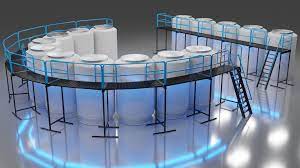The use of aluminium in cryogenic and electrical applications is not merely a matter of convenience; it’s a necessity. This section delves into the significance of aluminum in these fields.In cryogenic applications, the selection of materials is a critical aspect. The chosen cryogenic aluminium sections must be able to withstand the harsh conditions of extreme cold without losing its structural integrity or causing operational issues. Here, aluminum outperforms many other materials.
Aluminum alloys, in particular, have been found to exhibit excellent toughness at cryogenic temperatures. This property makes them ideal for use in the construction of cryogenic storage systems and superconducting magnets. Furthermore, aluminium has a low neutron absorption cross-section, making it suitable for use in nuclear research facilities where cryogenic conditions are often employed.
The role of aluminium in facilitating space exploration cannot be overstated. Spacecraft components need to be lightweight yet robust enough to survive in the extreme cold of space. Aluminium’s low density combined with its retained strength at cryogenic temperatures makes it an ideal choice for this purpose.
The Significance of Aluminium in Electrical Applications
In the field of electrical engineering, aluminium has made significant contributions. Its high electrical conductivity, coupled with its lower cost compared to copper, has made it a popular choice for electrical wiring. In fact, aluminium wiring is extensively used in utility grid systems around the world.
Aluminium’s natural resistance to corrosion is another significant advantage in electrical applications. Corrosion can lead to the degradation of electrical connections, resulting in reduced system performance. However, the protective oxide layer formed by aluminium when exposed to air effectively prevents this issue.
Moreover, aluminium’s excellent thermal conductivity makes it an ideal material for heat sinks in electronic devices. Heat sinks are vital for maintaining the operational efficiency of electronics by dissipating excess heat. Aluminium’s ability to conduct heat rapidly helps prevent overheating, extending the lifespan of electronic components.
Future Trends in Cryogenic Aluminium Sections & Electrical Aluminium Profiles
As technology continues to evolve, the demand for aluminum in both cryogenic and electrical applications is set to increase. The ongoing research in superconductors and quantum computing, which operate under cryogenic conditions, will likely necessitate further use of cryogenic aluminum sections.
Similarly, the push towards renewable energy sources and electric vehicles will drive the demand for electrical aluminum profiles. The growing need for power transmission lines, charging stations, and battery casings in electric vehicles present ample opportunities for aluminium.
Furthermore, the advancement in alloy technology is expected to produce aluminium alloys with even better properties. These new alloys could potentially revolutionize the way we use aluminium in cryogenic and electrical applications.
Cryogenic Aluminium Sections and Electrical Aluminium Profiles
Aluminium, a versatile and lightweight metal, is widely used in various industries due to its excellent physical and chemical properties. In this article, we delve into two specialized applications of aluminum: cryogenic aluminum sections and electrical aluminium profiles.
What are Cryogenic Aluminium Sections?
Cryogenics is the science that deals with the production, effects, and use of very low temperatures. Cryogenic aluminum sections are aluminium pieces designed to operate under these extreme conditions. These sections are utilized in industries where extremely low temperatures are required, such as space exploration, medical research, and superconducting magnet production.
Aluminium’s suitability for cryogenic applications stems from its unique properties. It retains its mechanical strength and ductility even at extremely low temperatures, unlike many materials that become brittle and prone to fracture. Additionally, aluminium has a low thermal expansion coefficient, meaning it does not expand or contract significantly with temperature changes. This stability is vital in cryogenic applications where materials are subjected to extreme temperature variations.
Applications of Cryogenic Aluminium Sections
Cryogenic aluminium sections have numerous applications. They are used in the construction of spacecraft, where materials need to withstand the intense cold of outer space. In the medical field, they’re used in the manufacturing of cryogenic storage containers for preserving biological samples. Moreover, in the energy sector, they are used in the construction of liquefied natural gas (LNG) storage tanks and pipelines.
What are Electrical Aluminium Profiles?
Electrical aluminium profiles refer to aluminium sections used in electrical applications. They are typically extruded into complex shapes to meet specific requirements and are used in electrical systems due to their excellent electrical conductivity and resistance to corrosion.
Why Aluminium for Electrical Applications?
Aluminium’s high electrical conductivity makes it a popular choice for electrical wiring and components. It conducts electricity almost as efficiently as copper but is significantly lighter and less expensive. Additionally, aluminium forms a protective oxide layer when exposed to air, making it resistant to corrosion. This resistance is particularly beneficial in electrical applications where corrosion can interfere with electrical conductivity.
Electrical aluminium profiles are used in a variety of applications. They are used in the production of electrical wires, cables, and connectors due to their excellent electrical conductivity. They are also used in the manufacture of heat sinks, which dissipate heat from electronic devices, preventing overheating. Furthermore, they are used in the construction of electrical enclosures, providing protection for electrical equipment against environmental factors.
Aluminum’s unique properties make it an ideal material for both cryogenic and electrical applications. Cryogenic aluminium sections provide the strength and stability required to withstand extreme cold, while electrical aluminum profiles offer excellent electrical conductivity and corrosion resistance. As technology continues to advance, the demand for these specialized aluminum products is expected to grow, further highlighting the importance of this versatile metal in modern industry.
Conclusion
In the realm of cryogenics and electrical applications, aluminum has proven itself as a material of choice due to its unique characteristics. Its strength at low temperatures, electrical and thermal conductivity, and resistance to corrosion make it indispensable in these fields. As we venture further into the era of technological advancement, the importance of aluminium in these applications is only set to grow.

